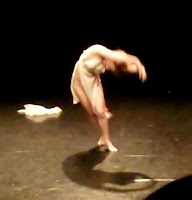Early modern dance artists wove multiple and sometimes seemingly contradictory influences into their dance works. For instance, they used terms such as “natural” to describe the style of their movement and advocated for a relationship between the human body and nature, celebrating seasonal cycles and an idealistic, perennial philosophical perspective.
 |
| "Sky," collaboration with Linda DeHart |
Yet, at the same time, they incorporated some of the newest scientific theory and technological advances into their performance presentations. Loie Fuller created fantastical moving images through innovations in costume technology and lighting design and influenced Duncan’s use of side lighting and warm colors. Duncan may have mothered a “natural” dance technique, but she used contemporary scientific metaphors as evidence to support her argument for a movement technique based on the physics of the human skeleton, efficient movement patterning, and harmonious proportions.
We know that Duncan was inspired by natural forces, like the wind in trees and ocean waves, but Duncan did not limit her understanding of wave movement to visible manifestations of the phenomena. “All energy expresses itself through this wave movement,” she wrote, “For does not sound travel in waves, and light also?” (Duncan, The Art of the Dance). Duncan advocated rediscovering the embodied knowledge of the ancient Greeks, and, at the same time, she used contemporary physics metaphors to describe her dance art.
 |
| Shooting green screen footage for CIM |
At the turn of the twenty-first century, we are again (or still?) in the midst of a technological revolution (evolution?). Our lives are being continually transformed by mobile technology, the internet, and digital media. We are constantly bombarded by digital media and sound bytes, pecking at our attention, fracturing our consciousness, and encouraging us to give in to whirlwind multi-tasking and the accompanying high-stress high.
Is there any way to utilize these new technological mediums for meditative and restorative ends? To create beauty in the world? This is the question posed by the creative team of Colors in Motion™, spearheaded by visual artist Linda DeHart, a veteran creator of large-scale public art commissions and longtime practitioner of Noyes Rhythm (for more context on Noyes, check out October’s post “Forest Breathing in Nutley, NJ”). DeHart’s latest project embraces the potential of new media to create atmosphere and transform space—and to do so with the goal of slowing people down, encouraging them to breath, and inviting them into an experience of tranquility, peace, and beauty.
Teaming up with artists from a variety of mediums, including filmmaker Christopher Graefe, poet Jeff Volk, composer Josh Hummel, me as dance artist, and arts integrator and Noyes Rhythm practitioner Susan Bayley, DeHart and Colors in Motion™ are crafting visual and sensorial art experiences that heal and transform. These multimedia experiences are effective on the small screens of phones and computers and are awe-inspiring as large-scale, full-wall architectural installations. Check out the Experiences page of Colors in Motion™ for samples of this innovative work or subscribe to receive monthly online experiences through Touchstone, art that changes people’s moods in public spaces.















